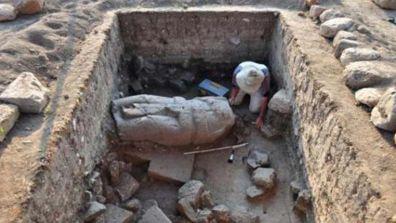Ancient Monolith Depicting Ballplayer Found in El-Teul
Source - http://latino.foxnews.com/latino/lifestyle/2011/06/16/ballplayer-monolith-found-in-northern-mexico/
Mexican archaeologists have found a new ballplayer monolith dating from between 900 A.D. and 1000 A.D at an archaeological site in the north-central state of Zacatecas, the National Anthropology and History Institute, or INAH, said.

The pre-Columbian sculpture was excavated from a depth of 1.5 meters (5 feet), the INAH said in a statement, noting that another sculpture depicting a ballplayer was located at the end of last year at the same complex, known as El Teul.
Experts say the two pieces may evoke the "divine twins" mentioned in the Popol Vuh, the sacred book of the Mayas.
The more recently discovered sculpture is an almost complete cylindrical figure that is 1.75 meters (5.7 feet) tall and measures 56 centimeters (22 inches) in diameter. It was found a few weeks ago at El Teul's ballgame court, the INAH said.
The sculpture fell to the ground after the collapse of one of the court's walls, the archaeologists in charge of the excavation work, Peter Jiménez and Laura Solar, said, adding that the piece was decapitated and only a fragment of one of the ears has been recovered.

CIV 101 : Civilisations précolombiennes mésoaméricaines / Mesoamerican Civilizations
El Teul, located on the like-named hill outside the Zacatecas town of Teul de Gonzalez Ortega, was one of the few settlements in the Americas that was continuously inhabited from 200 B.C. to the time of the Spanish conquest in the first half of the 16th century, the INAH said.
It was the ceremonial center par excellence of the Caxcanes, a partly nomadic group that fiercely resisted the Spanish conquistadors and was close to defeating them in the 1540-1542 Mixton War, archaeologists said.
The two ballplayer sculptures are unique among those found across Mesoamerica, archaeologist Luis Martínez Mendez, head of excavation work at the El Teul ball court, said.
Martínez said the two ballplayer monoliths - one initially designed as headless and the other with both head and body - "probably" allude to a Popol Vuh story in which one of the divine twins - Hunahpu and Ixbalanque - was decapitated before being saved by his brother.
A precise map drawn in the mid-19th century by German geodesic engineer Carl de Berghes showed the existence of several pre-Columbian constructions at El Teul - including a ball court whose four corners featured an equal number of sculptures, the archaeologist said.
Pieces of one of the other two sculptures have been found, possibly part of a shoulder, during excavation work in the court's northwest corner.
Archaeologists still must excavate another 15 percent of the ball court, which measures 24 meters (80 feet) by 44 meters (145 feet) and is scheduled to be opened to the public in 2012, Martínez said.